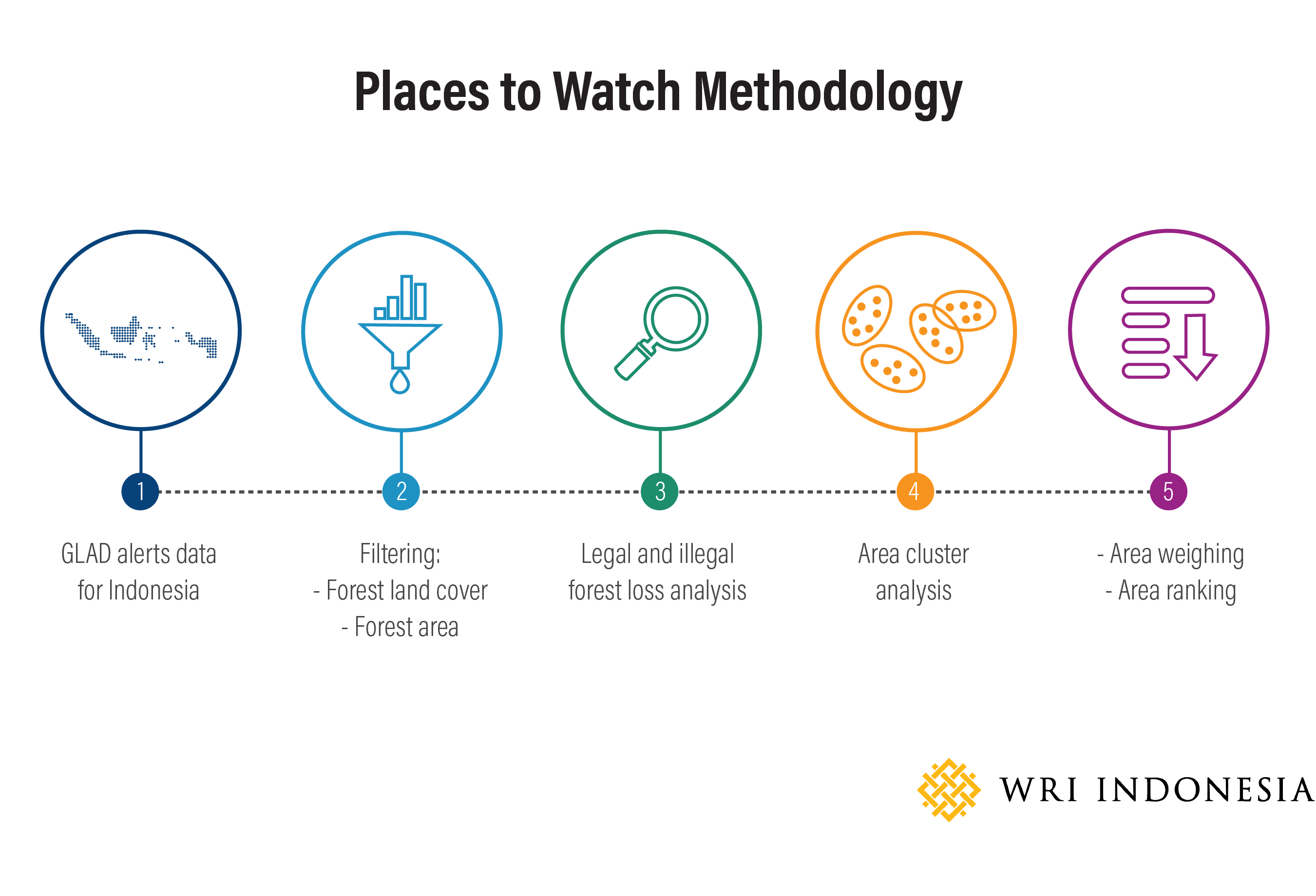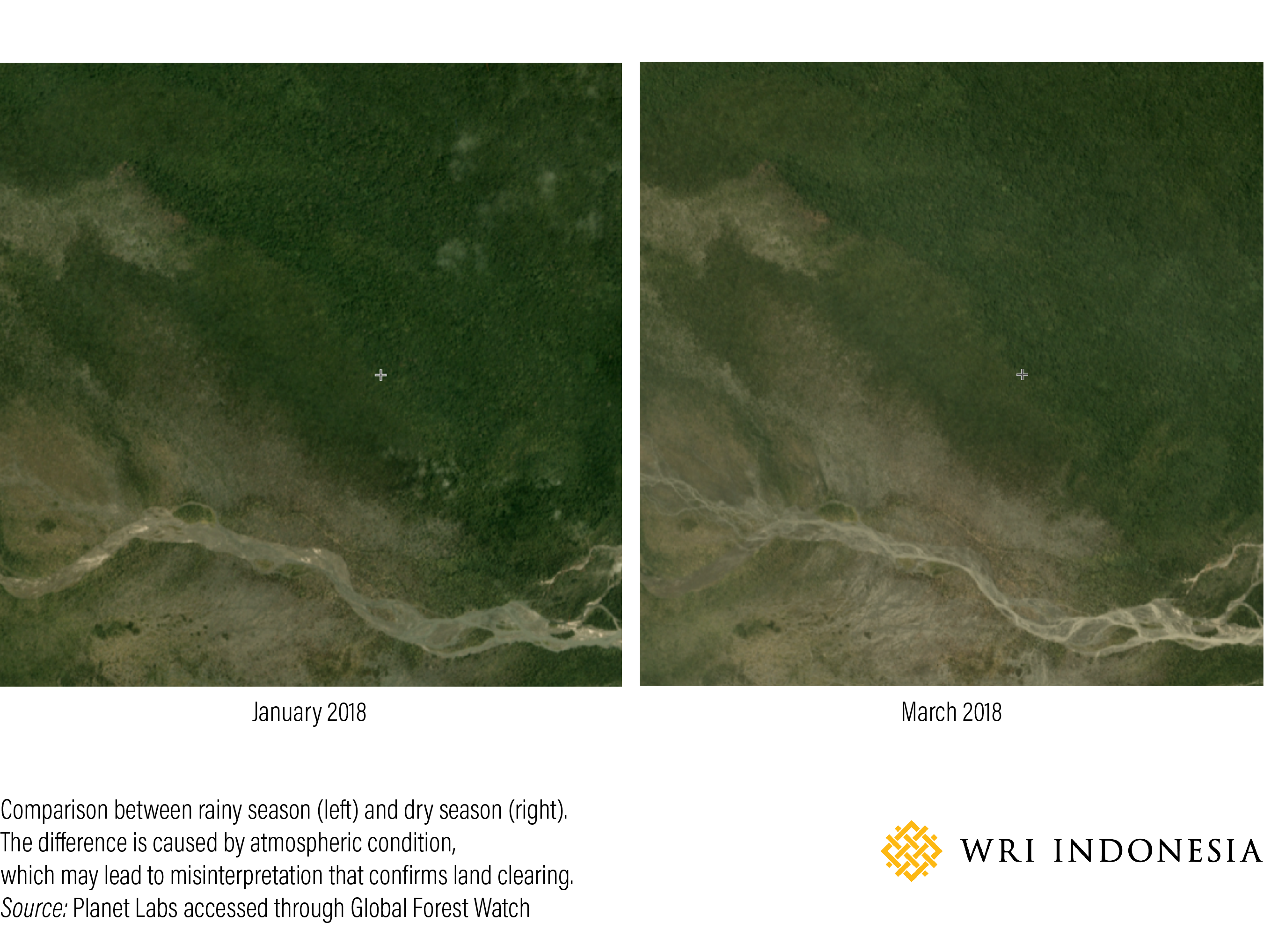'Pantau Jejak' Technical Blog: Identifying Priority Places to Watch for Illegal Logging
Pantau Jejak (Places to Watch): Illegal Logging Indications in Indonesia is an initiative to identify priority areas to watch for illegal logging in Indonesia based on indications. The list of places to watch is compiled and published every three months to inform stakeholders in monitoring and law enforcement pertaining to illegal logging in Indonesia.
The methodology used by Indonesia’s Places to Watch is a modified version of the methodology used by WRI’s regular Places to Watch to identify areas where large-scale illegal logging is indicated. There are two types of illegal logging: logging in forest area without a valid permit and logging with a valid permit that fails to comply with the requirements of the permit as stipulated in Law No. 18 of 2013 on Forest Degradation Prevention and Eradication. Due to the limitation of data, such as data on concession companies’ work plans, however, Places to Watch currently only covers the first illegality.
The Places to Watch methodology identifies areas with the highest number of tree cover loss alerts on a weekly basis (using the GLAD alerts)1 in areas where logging is legally prohibited. The methodology used by Places to Watch is as follows:

We use a 5x5 km grid cell and not a 10x10 km grid as in WRI’s Places to Watch methodology, because the ability to capture individual cause to forest cover loss is better in a 5x5 km grid cell. Further, we work on focus area images related to illegal logging activities using layers below:
- Forest cover2 data of primary and secondary forests from the Ministry of Environment and Forestry (MoEF). Forest cover data issued by KLHK is extracted, taking only primary and secondary forest cover and removing any industrial plantation forests data. We then overlap the GLAD alerts data with the forest cover data to identify biophysical clearing in forest cover areas, regardless of the legal status of the forest. The different forest cover classes are defined as follows: a) Primary forests are undisrupted or minimally disrupted forests from human activities, such as logging and logging path clearing; b) Secondary forests are majorly disrupted forested from human activities; c) Industrial forest plantations are monoculture plantations to be harvested in the next few years, followed by the replanting of the same crops in the next planting cycle. In Indonesia, most forest plantations are used for raw materials for pulp, such as acacia.
Forest areas have their own legal status as designated by the MoEF. We retrieve their status to identify indications of illegal clearing within the forest areas by function. Forest area is an area determined by the government, namely the MoEF, as forest, so it should not be used for non-forestry activities. This area is divided into three main functions, namely conservation (for the preservation and protection of plant and animal diversity and their ecosystems), protection (for the protection of life support systems such as water and disaster mitigation) and production (to produce forest products). The use of timber in the conservation and protected area is strictly prohibited, while the use of timber in protection area is prohibited except with a forest area borrow-to-use permit (izin pinjam pakai kawasan hutan/IPPKH). In production forests, timber utilization is permitted only in concession areas and if balanced with reforestation efforts. Meanwhile, any activity in production forest areas without permit is illegal.
Concession permit. The data lists permits issued for various concessions, including for selective logging or Business Licenses of Utilization of Forest Products – Natural Forest (IUPHHK-HA), Business Licenses of Utilization of Forest Products – Industrial Plantation Forest (HTI), Business Licenses of Utilization of Forest Products – Smallholder Forests (HTR), village forest, Business Licenses of Utilization of Forest Products – Community Forest (HKm) and forest area borrow-to-use permit. Based on the regulations, land clearing activities inside the concession area are possible, so we employ this following layer to remove legal forest clearing.
Afterwards, we overlapped GLAD alerts with the focus areas and the 5x5 km cells. Scores for each cell grid were then calculated by referring to the number of GLAD alerts against the proportion of the focus area in each 5 km grid. We then selected the top 10 areas for further verification using high-resolution satellite images. Next, we used the Queen's Case Neighborhood method to detect the locations of the top 10 areas with cell grids that coincided diagonally and vertically and that generated large volumes of GLAD alerts. This method grouped adjacent 5x5 km cells into one neighboring cell groups. All of these areas might then represent a similar cause to a specific forest cover loss incident (for example due to mining activities or clearing for plantations). Top 10 areas were then identified using high-resolution satellite images (Planet and Google Earth Pro) with two goals: first is to verify the forest cover loss and second is to identify the cause of forest cover loss.

Verification of the GLAD alerts using high-resolution satellite images is designed to remove false positives, where forest cover loss is detected by GLAD alerts but does not actually occur. There are several causes of false positive:
- High cloud coverage

- Transition period from rainy season to dry season

After removing false positives and verifying forest clearing in the areas monitored, we identified the causes of forest clearing in each area. We then conducted an initial verification through literature studies, which aimed to provide additional information from secondary data about the development of illegal logging in the top five areas. The secondary data certainly cannot be interpreted as a final verification to the indicated area, but it can serve as an initial guide for further verification.
-
GLAD alerts from the University of Maryland via Global Forest Watch. The GLAD alerts provide weekly tree cover loss information in 30x30 meters pixel data, which is analyzed using landsat satellite imagery. Each GLAD alert represents 30x30 meters pixel of 50 percent or more estimated forest loss within a 0.01 hectare area, as elaborated in this article. ↩︎
-
Data on forest/land cover, forest area and permit is sourced from the MoEF’s geoportal http://geoportal.menlhk.go.id/arcgis/rest/services/KLHK where forest/land cover data is updated every six months and permit data is updated from time to time. Every place to watch blog uses the latest data for each layer for better context in terms of illegal logging. ↩︎